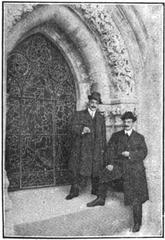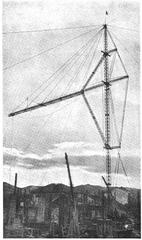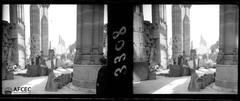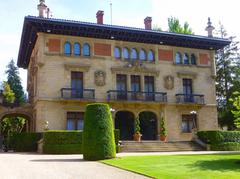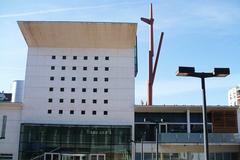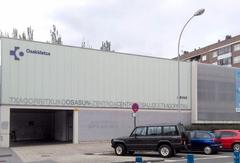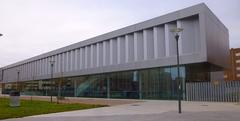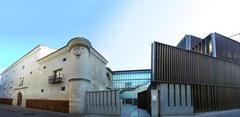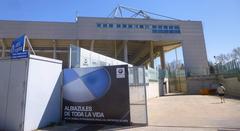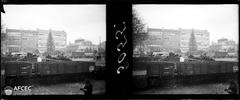
Visiting Hours and Tickets for Catedral de María Inmaculada in Vitoria-Gasteiz
Date: 23/07/2024
Introduction to the Catedral de María Inmaculada
The Catedral de María Inmaculada, also known as the New Cathedral of Vitoria-Gasteiz, stands as a monumental testament to Gothic Revival architecture and the rich cultural heritage of the Basque Country. Located in the heart of Vitoria-Gasteiz, Spain, this cathedral is not only a place of worship but also a symbol of the city’s historical and spiritual journey. The idea for this grand structure was conceived in the early 20th century to meet the needs of a growing population, culminating in its consecration in 1969. Designed by the visionary architects Julián Apraiz and Javier de Luque, the cathedral features classic Gothic elements such as pointed arches, ribbed vaults, and flying buttresses, embodying both spiritual significance and architectural brilliance (Catedral de María Inmaculada, Spain.info).
Throughout its tumultuous construction period, which was marred by financial difficulties and the Spanish Civil War, the cathedral emerged as a beacon of resilience and faith for the community. Today, it serves not only as a religious center but also as a cultural and artistic hub, hosting numerous events, art exhibitions, and guided tours (Basque Tourism, Diocese of Vitoria). This comprehensive guide will take you through the cathedral’s history, architectural marvels, visitor information, and travel tips to ensure a memorable visit to one of Vitoria-Gasteiz’s most iconic landmarks.
Table of Contents
- Introduction
- History of Catedral de María Inmaculada / Maria Sortzez Garbiaren Katedrala
- Visitor Information
- Visitor Experience
- FAQ
- Conclusion
History of Catedral de María Inmaculada / Maria Sortzez Garbiaren Katedrala
Origins and Construction
The idea for a new cathedral emerged in the early 20th century, driven by the need for a larger ecclesiastical space to accommodate the growing population of Vitoria-Gasteiz. The foundation stone was laid on August 4, 1907, marking the beginning of a significant architectural endeavor (Catedral de María Inmaculada).
Architectural Design
The cathedral was designed by architects Julián Apraiz and Javier de Luque, who envisioned a structure that would embody the grandeur and spiritual significance of Gothic architecture. The design features pointed arches, ribbed vaults, and flying buttresses, which are characteristic of the Gothic style. The cathedral’s layout follows a Latin cross plan, with a central nave flanked by aisles and a transept that intersects the nave (Spain.info).
Construction Challenges
The construction of the cathedral faced numerous challenges, including financial constraints and interruptions caused by political turmoil. The Spanish Civil War (1936-1939) significantly delayed progress, and it wasn’t until 1969 that the cathedral was finally consecrated. Despite these setbacks, the dedication to completing the cathedral remained unwavering, reflecting the community’s commitment to their faith and heritage (Catedral de María Inmaculada).
Significance and Dedication
The cathedral is dedicated to the Immaculate Conception of the Blessed Virgin Mary, a central figure in Catholic theology. This dedication underscores the cathedral’s role as a spiritual center for the community, providing a place for worship, reflection, and communal gatherings. The choice of dedication also aligns with the broader Catholic tradition of venerating Mary as a symbol of purity and divine grace (Spain.info).
Artistic and Cultural Contributions
The Catedral de María Inmaculada is not only a place of worship but also a repository of art and culture. The interior of the cathedral is adorned with numerous works of art, including stained glass windows, sculptures, and paintings that depict various religious themes. These artistic elements contribute to the cathedral’s aesthetic appeal and spiritual ambiance, enhancing the overall experience for visitors and worshippers alike (Catedral de María Inmaculada).
Modern Developments
In recent years, the cathedral has undergone several restoration and conservation projects to preserve its structural integrity and artistic heritage. These efforts ensure that the cathedral remains a vibrant and accessible space for future generations. Additionally, the cathedral has embraced modern technology, offering virtual tours and digital resources to engage a broader audience and promote its historical and cultural significance (Catedral de María Inmaculada).
Historical Events and Milestones
Throughout its history, the Catedral de María Inmaculada has been the site of numerous significant events and milestones. These include the consecration ceremonies, visits by prominent religious figures, and various community celebrations. Each of these events has contributed to the cathedral’s rich historical tapestry, reinforcing its status as a cornerstone of Vitoria-Gasteiz’s religious and cultural identity (Spain.info).
Visitor Information
Visiting Hours and Tickets
To fully appreciate the grandeur of the Catedral de María Inmaculada, visitors can explore the cathedral during its opening hours. The cathedral is open to the public from Monday to Saturday, 10:00 AM to 6:30 PM, and on Sundays from 1:30 PM to 6:30 PM. Tickets can be purchased at the entrance or online through the cathedral’s official website. General admission tickets are priced at €5, with discounts available for students, seniors, and groups (Catedral de María Inmaculada).
Travel Tips
When planning your visit, consider exploring nearby attractions such as the historic old town of Vitoria-Gasteiz, the Museo de Bellas Artes, and the Florida Park. The cathedral is easily accessible by public transport, with several bus lines stopping nearby. For those driving, parking facilities are available within walking distance (Basque Tourism).
Accessibility
The Catedral de María Inmaculada is committed to being accessible to all visitors. Ramps and elevators are available for those with mobility challenges, and guided tours can be arranged for visitors with special needs (Vitoria-Gasteiz Tourism).
Special Events and Guided Tours
The cathedral hosts various special events throughout the year, including religious ceremonies, concerts, and art exhibitions. Guided tours are available in multiple languages, offering deeper insights into the cathedral’s history, architecture, and art. Photographic spots within the cathedral provide perfect opportunities to capture its stunning beauty (Catedral de María Inmaculada).
Frequently Asked Questions (FAQ)
Q: What are the visiting hours for Catedral de María Inmaculada?
A: The cathedral is open from Monday to Saturday, 10:00 AM to 6:30 PM, and on Sundays from 1:30 PM to 6:30 PM.
Q: How much are the tickets for Catedral de María Inmaculada?
A: General admission tickets are priced at €5, with discounts available for students, seniors, and groups.
Q: Is the Catedral de María Inmaculada accessible for people with disabilities?
A: Yes, the cathedral is accessible, with ramps and elevators available for those with mobility challenges.
Q: Are guided tours available?
A: Yes, guided tours are available in multiple languages and can be arranged through the cathedral’s official website.
Conclusion
The history of the Catedral de María Inmaculada is a story of perseverance, faith, and artistic achievement. From its inception in the early 20th century to its present-day status as a cultural and spiritual landmark, the cathedral embodies the rich heritage and enduring spirit of Vitoria-Gasteiz. As visitors walk through its hallowed halls, they are invited to reflect on the profound historical journey that has shaped this magnificent edifice. Plan your visit today to explore the Catedral de María Inmaculada and immerse yourself in its timeless beauty and significance (Spain.info).
